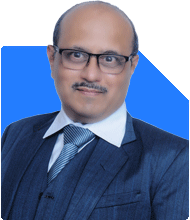Ramalingam Kalirajan |10881 Answers |Ask -Follow
Mutual Funds, Financial Planning Expert - Answered on May 15, 2025
He has an MBA in finance from the University of Madras and is a certified financial planner.
He is the director and chief financial planner at Holistic Investment, a Chennai-based firm that offers financial planning and wealth management advice.... more
.jpg)
I am 45 years old I want retire at 60 life expectancy 80 how much amount needed after 15 years for retirement.no medical expenses.i have planned for medical expenses.current monthly expenses are 20000 how much Corpus need for 20 years 60 to 80
You are 45 years old today.
You plan to retire at 60.
You expect to live till age 80.
So, you need to plan for 20 years of retirement.
You are spending Rs. 20,000 per month today.
You have already arranged separately for medical needs.
That shows smart thinking.
Let us now evaluate how much money you will need when you turn 60.
We will also understand how to build that amount in the next 15 years.
This is a 360-degree assessment.
Clear. Simple. Analytical.
Retirement Expense Projection – Why Future Value Is Higher Than Today
You spend Rs. 20,000 per month today.
This cost will go up every year due to inflation.
Prices of food, clothing, travel, and other needs will increase.
Even without medical costs, inflation will hit all other areas.
If inflation is around 6%, then your monthly expense at age 60 will rise.
It won’t stay Rs. 20,000. It may become over Rs. 48,000 per month at age 60.
That means your yearly expense will be over Rs. 5.8 lakh at retirement.
This will increase every year till age 80.
So you will not need a fixed sum every year.
You will need increasing amounts every year after retirement.
That is why your retirement corpus must be planned carefully.
It must give income for 20 years.
And the income must also grow with inflation.
Why a Larger Corpus Is Required Than Just 20 Years x Expense
Many people wrongly multiply Rs. 5.8 lakh with 20 years.
They think Rs. 1.2 crore is enough. That is wrong.
Why? Because your expenses will not remain flat.
They will increase every year after age 60.
From Rs. 5.8 lakh, they may reach Rs. 9 to 10 lakh annually at age 70.
And even more by age 80.
So you need a rising income from your retirement corpus.
Your money must last and grow at the same time.
You will also keep this corpus invested after age 60.
That means the money must earn returns.
At the same time, you will withdraw every year.
So the portfolio must be inflation-proof, risk-managed, and return-generating.
That needs careful asset allocation.
Not all money should go into FD or debt.
Some part must stay in equity mutual funds to beat inflation.
Recommended Retirement Corpus at Age 60
Considering your future expense growth and 20-year duration, you will need a large corpus.
If you want to spend around Rs. 5.8 lakh in the first year, and rising every year,
You will need a retirement corpus of around Rs. 1.8 to 2 crore.
This is a rough estimated figure.
It will allow you to withdraw rising income for 20 years.
It also assumes you keep money invested wisely after age 60.
It does not count any pension or family support.
If you want to leave behind any legacy for children, you will need more.
This Rs. 2 crore is for you and spouse to live with dignity.
It includes normal lifestyle, travel, occasional leisure, and gifts.
Not just rice-dal-roti.
Time Left: You Have 15 Years to Build This Corpus
You are currently 45. Retirement is planned at age 60.
So you have a good 15 years to save and invest.
This is enough time to build a Rs. 2 crore retirement corpus.
But you must be very consistent.
And you must follow a smart investment approach.
Not just savings or FDs.
Not gold or land.
Not LIC or ULIP policies.
Not endowment plans or money-back policies.
Only mutual funds via MFDs with CFP credentials will help you build this goal.
What to Do Monthly to Build Rs. 2 Crore in 15 Years
Start a Systematic Investment Plan (SIP) every month.
A SIP of around Rs. 30,000 to Rs. 35,000 can help you reach close to Rs. 2 crore.
If you already have any lump sum, invest that wisely too.
Choose regular mutual funds. Avoid direct funds.
Direct funds do not provide expert handholding or guidance.
They are suitable only for professionals who track markets full time.
Regular mutual funds allow you to invest with expert guidance of CFPs.
You need active fund management and human monitoring.
That comes only with CFP-guided MFD investing.
Avoid index funds also. They give average returns.
They do not beat inflation consistently in India.
They also fall heavily during bear markets.
Index funds don’t have downside protection.
Actively managed funds choose better sectors and stocks.
They help your SIP grow faster and stay resilient.
Keep Your Retirement Portfolio Flexible and Balanced
Don’t put all in equity. That is risky.
Don’t keep all in debt. That is too conservative.
Balance it smartly between equity and debt funds.
Use hybrid mutual funds as well.
They give stability and growth in one product.
Diversify across large-cap, flexi-cap, and mid-cap funds.
Use short-duration debt funds to park any lump sum.
Review your portfolio once every year.
Don’t react to every market move.
Be patient. Retirement planning is long term.
What Happens at Retirement Age?
When you turn 60, your retirement phase begins.
You stop earning salary. But your expenses will continue.
Your retirement corpus must give you income each year.
You can use a Systematic Withdrawal Plan (SWP).
This allows you to withdraw fixed amounts monthly.
At the same time, the balance stays invested.
It keeps earning returns and grows.
This way, your corpus lasts longer.
You will pay taxes only on the gains.
Mutual funds are more tax-efficient than FDs.
FDs tax the whole interest amount.
Equity mutual funds tax only capital gains.
Long-Term Capital Gains above Rs. 1.25 lakh is taxed at 12.5%.
STCG is taxed at 20%. But this is manageable through staggered withdrawals.
Debt mutual fund gains are taxed as per your slab.
Some Extra Points to Keep in Mind
Don’t fall for insurance policies that promise returns.
Avoid ULIPs, traditional LIC policies, and endowments.
These give poor returns, mostly under 5% per year.
Surrender them early if you already hold such plans.
Reinvest the money in mutual funds instead.
Keep at least 6 months’ expenses in emergency funds.
Keep a term insurance till age 60.
Don’t keep term plans after retirement. Not needed then.
You have already planned for health. That is excellent.
So your focus should be on building income-producing assets.
Not real estate, not gold, not bank FDs.
Only mutual funds offer flexibility, growth, and liquidity.
Finally
You need Rs. 2 crore at age 60 to live well for 20 years.
Your current expense of Rs. 20,000 will rise to Rs. 48,000 by retirement.
Inflation will keep increasing your cost of living.
You have 15 years left to build this Rs. 2 crore.
SIP of Rs. 30,000+ per month with guidance can help you reach this.
Avoid direct funds, index funds, and annuities.
Use regular mutual funds with CFP-guided MFD services.
Don’t try to do this alone. Get professional review annually.
Use equity and hybrid funds wisely.
At retirement, switch to SWP to generate monthly income.
Stay disciplined. Stay invested. Don’t panic in market dips.
You are on the right track by asking this now.
Early clarity gives future comfort. Keep going strong.
Best Regards,
K. Ramalingam, MBA, CFP,
Chief Financial Planner,
www.holisticinvestment.in
https://www.youtube.com/@HolisticInvestment
You may like to see similar questions and answers below
Sunil Lala | Answer |Ask -Follow
Financial Planner - Answered on Feb 11, 2024
Ramalingam Kalirajan |10881 Answers |Ask -Follow
Mutual Funds, Financial Planning Expert - Answered on May 07, 2024
Ramalingam Kalirajan |10881 Answers |Ask -Follow
Mutual Funds, Financial Planning Expert - Answered on May 10, 2024
Ramalingam Kalirajan |10881 Answers |Ask -Follow
Mutual Funds, Financial Planning Expert - Answered on Apr 23, 2025
Nitin Narkhede | Answer |Ask -Follow
MF, PF Expert - Answered on Jun 01, 2025
Dr Dipankar Dutta |1839 Answers |Ask -Follow
Tech Careers and Skill Development Expert - Answered on Dec 13, 2025
Dr Dipankar Dutta |1839 Answers |Ask -Follow
Tech Careers and Skill Development Expert - Answered on Dec 13, 2025
Mayank Chandel |2575 Answers |Ask -Follow
IIT-JEE, NEET-UG, SAT, CLAT, CA, CS Exam Expert - Answered on Dec 13, 2025
Radheshyam Zanwar |6742 Answers |Ask -Follow
MHT-CET, IIT-JEE, NEET-UG Expert - Answered on Dec 13, 2025
Mayank Chandel |2575 Answers |Ask -Follow
IIT-JEE, NEET-UG, SAT, CLAT, CA, CS Exam Expert - Answered on Dec 13, 2025
Mayank Chandel |2575 Answers |Ask -Follow
IIT-JEE, NEET-UG, SAT, CLAT, CA, CS Exam Expert - Answered on Dec 13, 2025
Kanchan Rai |646 Answers |Ask -Follow
Relationships Expert, Mind Coach - Answered on Dec 12, 2025
Ravi Mittal |677 Answers |Ask -Follow
Dating, Relationships Expert - Answered on Dec 12, 2025
Ramalingam Kalirajan |10881 Answers |Ask -Follow
Mutual Funds, Financial Planning Expert - Answered on Dec 12, 2025
Ramalingam Kalirajan |10881 Answers |Ask -Follow
Mutual Funds, Financial Planning Expert - Answered on Dec 12, 2025

























